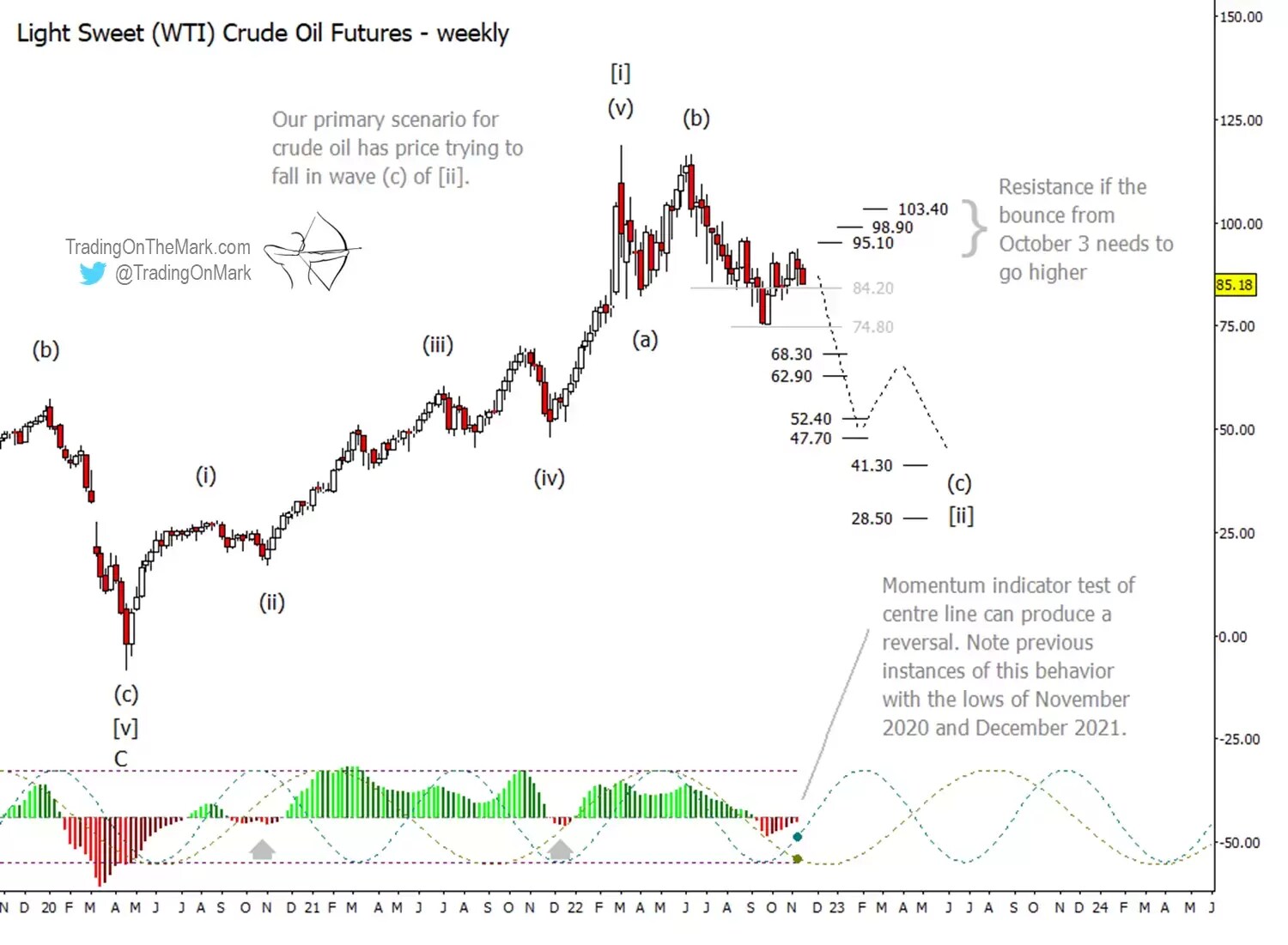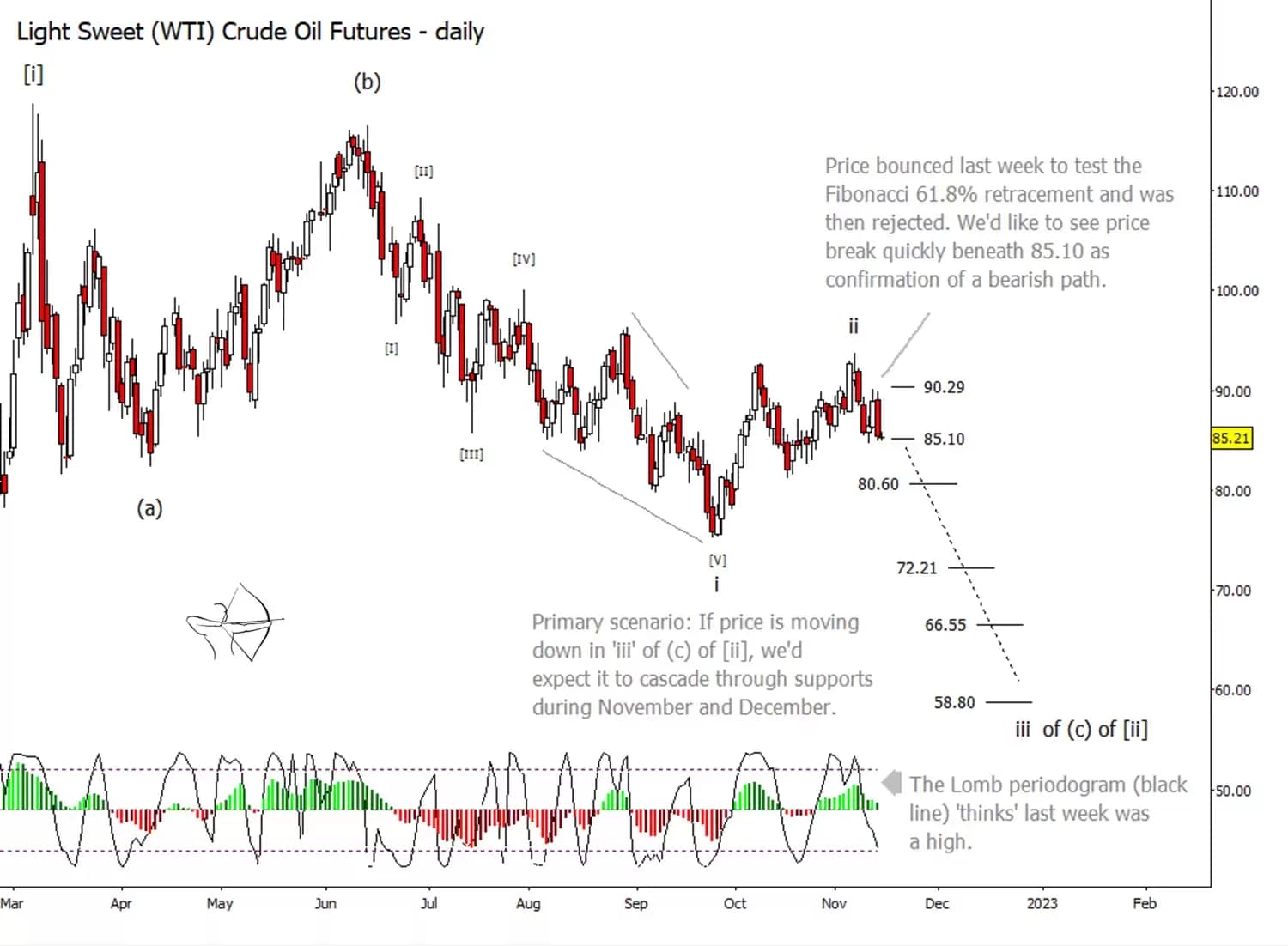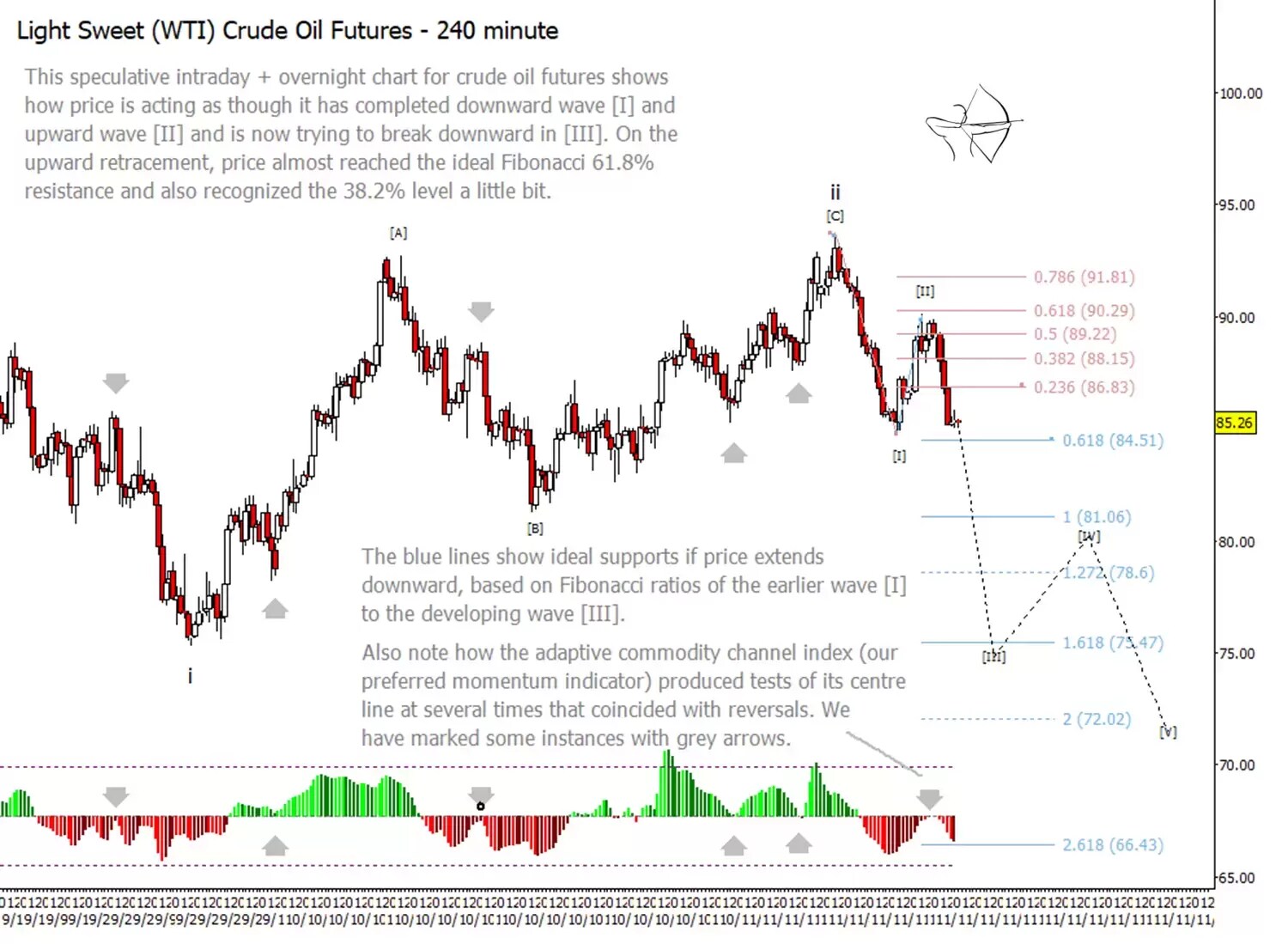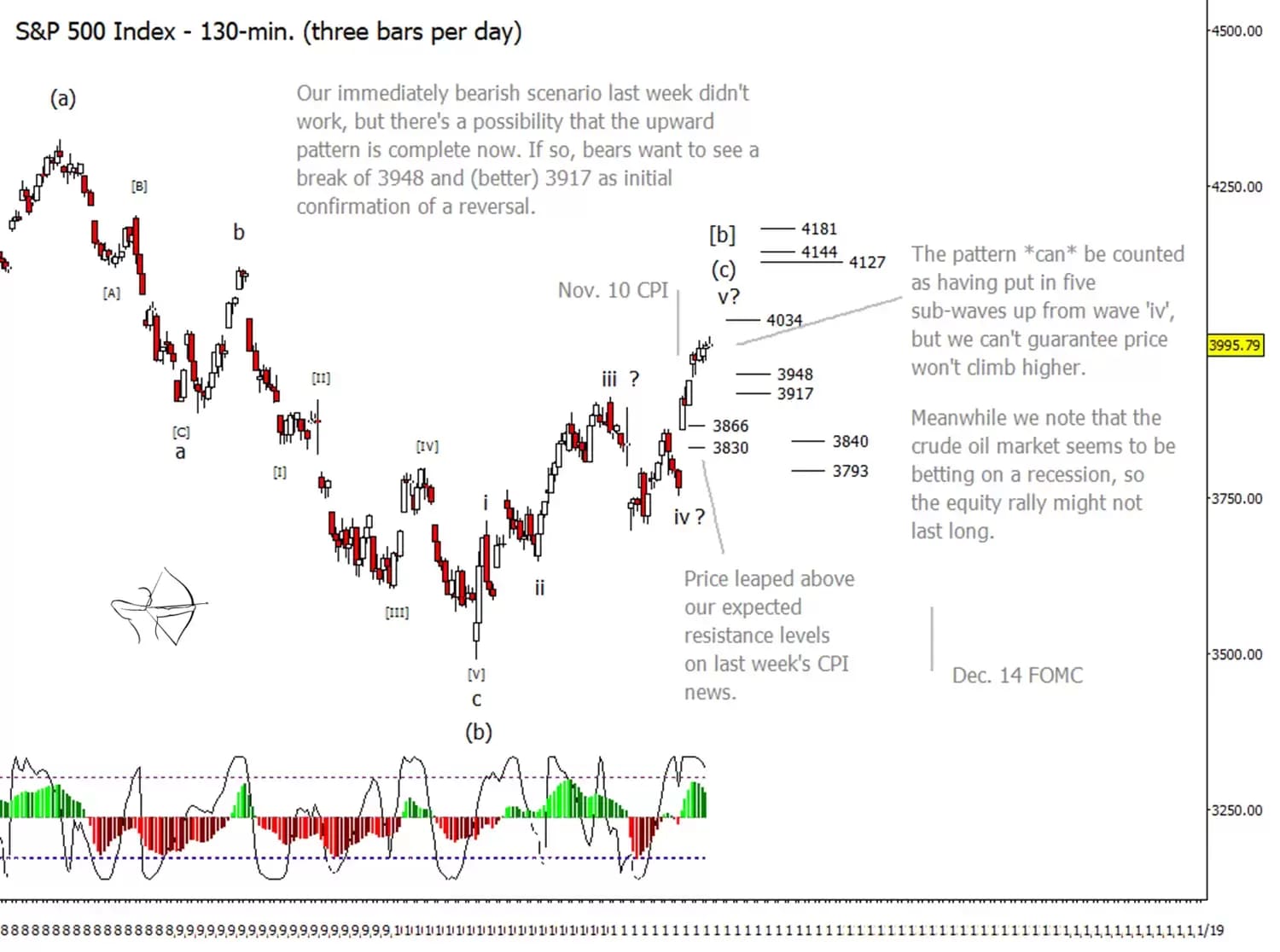
Following the spectacular rise in crude oil prices in March, we have been monitoring subsequent price action in the context of a downward retracement. Here we analyse prices for US benchmark West Texas Intermediate (WTI) crude using Elliott Wave techniques on a weekly, daily and intraday basis to produce a forecast up to the end of the year. We also provide an update on the article we wrote last week about the Dow and S&P 500.
WTI crude breaking below $84.20 would send bearish signal
We are treating the climb from the 2020 Covid low as wave [i] in what we expect will become a substantially larger upward pattern in the coming years. However, in the nearer term the charts below show what we believe is downward wave [ii] that is retracing part of the advance.
A second wave typically has three parts, and on the weekly chart we have labelled what we believe are sub-waves (a) and (b), with price now working on downward (c). C waves should consist of five parts, and we have drawn a speculative five-part path downward through the macro supports that can be calculated based on weekly bars. The first confirmation of a bearish path on this time frame would be a break and weekly close beneath $84.20, with a break below $74.80 providing additional encouragement for bears.

In case the expected downward reversal fails to take hold near the current area, we have marked additional resistance levels to watch.
Daily chart flags $85.10 as key level to watch
Traders who work on a daily time frame might wish to seek trades in the context of the downward i-ii-iii-iv-v structure that should comprise wave (c). We have drawn part of the expected path on the daily chart below. On this scale, the first confirmation of the downward break would be a failure of support at $85.10. This support level held when tested last week and on Monday. Note that price closed on Monday near the day's low, which is a bearish sign.
If price starts to slide, then $80.69 will probably represent a minor speed bump on the way down. More important daily supports wait at $72.21, $66.55 and $58.80. As price moves through those areas there might be opportunities for the pattern to extend and accelerate, but the initial conservative expectation would be for downward wave 'iii' to consist of five simple waves that would be visible on daily and intraday time frames.
Overlaid on the momentum indicator below is another of our favourite trading tools – the Lomb periodogram. Its algorithm attempts to discern the market's current phase in terms of an assumed price or time cycle. Last week the Lomb signalled that price was probably making a cyclical high.

Intraday chart highlights support at $81.06 and below
Whenever we suspect a retrace is happening, either upward or downward, our first analytic step is to compare price movement to a set of ideal retracement values. One such set of values includes the Fibonacci ratios shown with the red lines on the intraday chart below. (A 50% retracement is not really a Fibonacci ratio, but we include it here because sometimes the market notices it too.) WTI crude bears who traded on an intraday basis off the 61.8% retracement area had a good day on Monday.
A similar set of ratios comes into play when we are comparing the sizes of waves going in the same direction. For example, a third wave and fifth wave in a five-wave sequence often have Fibonacci relationships to the distance that price travelled in the preceding first wave. Our extension tool produced the supports shown in blue on the intraday chart, based on the size of wave [I] and measured from the top of wave [II].
One of the three inflexible rules of Elliott Wave methodology is that a third wave in a five-wave sequence must not be the shortest among waves one, three and five. That rule helps us assign probabilities to the targets shown below for wave [III]. For example, while price could find brief support at $84.51, it still would have travelled only 61.8% of the distance of wave [I] Lower supports at $81.06, $78.60, and $75.47 are more attractive as targets for a wave [III].

Earlier we showed how the adaptive commodity channel index on a weekly time frame can produce a test of the centre line when a reversal is more likely. The CCI on the intraday WTI crude chart, above, shows even more examples of the same behaviour, as marked by grey arrows. Not every momentum indicator has this tendency, but each type has its own advantages. If the CCI is not available in your charting platform, we recommend experimenting with other momentum indicators and studying how they behave particularly around price reversals.
S&P 500 moved higher last week, but rally could be brief
Finally, we offer an update on last week's charts for the S&P 500 Index. We projected that price could break lower on Thursday’s US inflation data, but instead it hopped above the resistance level that we identified at 3,866 as consumer price growth eased to 7.7% in October – a cooler increase than the 8% uptick that economists had expected.
Our primary scenario for the index is still bearish over the course of the next several months, but it's unclear whether the index is ready for a reversal right now. Technically, the move up from what we have marked as wave 'iv' on the chart below can be counted as five waves, making it a candidate for completion of this segment of the pattern. However bears would want to see confirmation first with a break of supports at 3,948 and 3,917.
If price continues to climb during the next few weeks, we will watch the resistance areas at 4,034, 4,127, 4,144, and 4,181 as additional areas where the pattern might finish.
We note that the CCI suggests that the market may be overbought, but it has not yet put in a divergence that would increase our confidence of a reversal being imminent.

For more technical analysis from Trading On The Mark, follow them on Twitter. Trading On The Mark's views and findings are their own, and should not be relied upon as the basis of a trading or investment decision. Pricing is indicative. Past performance is not a reliable indicator of future results.
Disclaimer: CMC Markets is an execution-only service provider. The material (whether or not it states any opinions) is for general information purposes only, and does not take into account your personal circumstances or objectives. Nothing in this material is (or should be considered to be) financial, investment or other advice on which reliance should be placed. No opinion given in the material constitutes a recommendation by CMC Markets or the author that any particular investment, security, transaction or investment strategy is suitable for any specific person. The material has not been prepared in accordance with legal requirements designed to promote the independence of investment research. Although we are not specifically prevented from dealing before providing this material, we do not seek to take advantage of the material prior to its dissemination.























